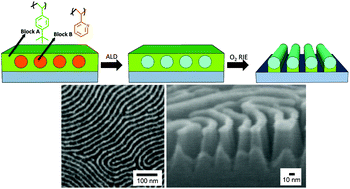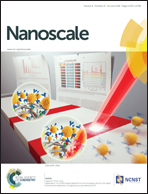Patterning at the 10 nanometer length scale using a strongly segregating block copolymer thin film and vapor phase infiltration of inorganic precursors†
Abstract
In this work, we demonstrate the use of self-assembled thin films of the cylinder-forming block copolymer poly(4-tert-butylstyrene-block-2-vinylpyridine) to pattern high density features at the 10 nm length scale. This material's large interaction parameter facilitates pattern formation in single-digit nanometer dimensions. This block copolymer's accessible order–disorder transition temperature allows thermal annealing to drive the assembly of ordered 2-vinylpyridine cylinders that can be selectively complexed with the organometallic precursor trimethylaluminum. This unique chemistry converts organic 2-vinylpyridine cylinders into alumina nanowires with diameters ranging from 8 to 11 nm, depending on the copolymer molecular weight. Graphoepitaxy of this block copolymer aligns and registers sub-12 nm diameter nanowires to larger-scale rectangular, curved, and circular features patterned by optical lithography. The alumina nanowires function as a robust hard mask to withstand the conditions required for patterning the underlying silicon by plasma etching. We conclude with a discussion of some of the challenges that arise with using block copolymers for patterning at sub-10 nm feature sizes.


 Please wait while we load your content...
Please wait while we load your content...